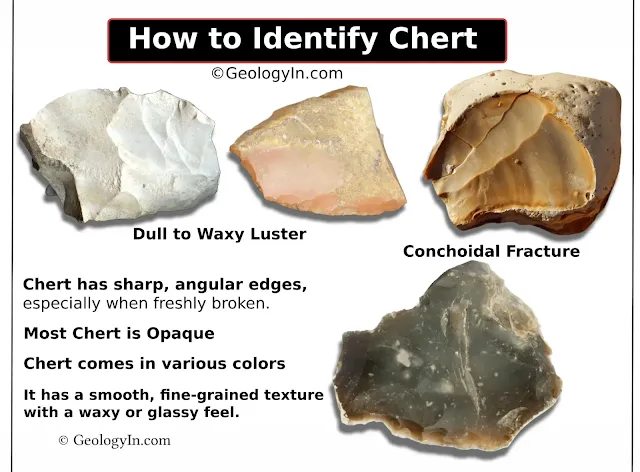How to Identify Chert
Chert, a sedimentary rock primarily composed of microcrystalline quartz (silicon dioxide, SiO₂), is recognized for its durability and distinctive conchoidal fracture, properties historically crucial for tool-making. Accurately identifying chert involves assessing key physical properties—such as its hardness, fracture style, luster, and color—which differentiate it from rocks like limestone and help characterize its well-known varieties, including flint and jasper.
This guide provides a systematic approach to chert identification, examining these diagnostic features and considering its typical geological context to ensure confident recognition.
What is Chert?
Chert forms from the slow accumulation of silica, often derived from the microscopic remains of marine organisms like radiolarians or diatoms. Over time, this silica hardens into a dense, fine-grained rock found in places like limestone or chalk beds, riverbanks, or coastal beaches. Its historical significance—from arrowheads to fire-starting flint—makes spotting chert a rewarding challenge. Let’s dive into its key identifiers.
 |
Identifying chert by its smooth, fine-grained texture, waxy surface luster, and sharp, angular broken edges. |
Chert Visual Characteristics
Color: Chert exhibits a wide color range, including gray (most common), brown, red, white, black, green, or less commonly yellow, blue, or purple. Color variations result from impurities: iron oxides produce red hues (jasper), organic material yields gray to black (flint), and pure silica appears white to light gray.
Luster: Fresh surfaces display a waxy to dull luster, occasionally slightly glossy when freshly broken. Polished chert may show a subtle shine but lacks a brilliant glassy luster.
Texture: Chert has a smooth, dense, and microcrystalline texture. Crystals are too small to be visible without magnification, distinguishing it from granular rocks like sandstone or quartzite.
Physical Characteristics
Hardness: Chert has a Mohs hardness of 7–8, resisting scratches from steel (hardness ~5.5). It can scratch glass, making this a reliable field test.
Fracture: Chert exhibits conchoidal fracture, breaking with smooth, curved surfaces resembling broken glass. This produces sharp edges, a hallmark feature.
Density: Chert is dense, with a specific gravity of 2.6–2.7 g/cm³, feeling heavy for its size compared to other rocks.
Transparency: Most chert is opaque, though varieties like agate may be slightly translucent.
Streak: When scraped on unglazed porcelain, chert leaves a white streak.
 |
| Chert. |
Geological Context
Chert is commonly found in three primary forms:
- Nodules or concretions within limestone or chalk beds, typically encased in a chalky outer rind.
- Bedded chert, occurring as distinct layered deposits.
- Resistant pebbles and cobbles in riverbeds and gravels, owing to its exceptional hardness and durability.
- Tool-Assisted Tests: Carry a steel nail for hardness testing, a 10x hand lens for inspecting texture, and dilute hydrochloric acid (HCl) for carbonate identification.
Field Tests for Chert Identification
To accurately identify chert in the field, use the following diagnostic methods:
Hardness Test: Attempt to scratch the sample with a steel nail or knife (~Mohs hardness 5.5). True chert will resist scratching and can scratch glass, confirming its high hardness. Softer, easily abraded materials are not chert.
Break Test: Chert often has a weathered cortex or limestone rind. Break the sample to expose the characteristic waxy, smooth interior.
Fracture Test: Break a small piece to observe the fracture surface. Chert exhibits a conchoidal fracture with sharp, smooth, often waxy-looking surfaces—hallmarks of microcrystalline quartz.
Edge and Shape Evaluation: Due to its resistance to weathering and erosion, chert typically retains sharp, angular edges rather than becoming rounded.
Sound Test: Gently strike two samples or tap with a metal object. Chert emits a clear, bell-like ring, unlike the dull thud of limestone.
Spark Test: In a dark setting, strike the sample against steel. High-quality chert, such as flint, generates visible sparks, a property historically exploited in fire-starting.
Acid Test: Apply dilute HCl to test for carbonate content. Chert is chemically inert and shows no effervescence, distinguishing it from limestone or dolomite.
Streak Test: Drag the specimen across unglazed porcelain. Chert typically leaves a white streak, helping differentiate it from metallic or dark-colored minerals.
Hand Lens Inspection: Examine the fresh surface with a hand lens to confirm the microcrystalline quartz texture, which differentiates chert from coarser-grained siliceous or carbonate rocks.
Distinguishing Chert from Similar Materials
Chert vs. Flint
Flint is a dark gray to black variety of chert. Both share identical chert characteristics (hardness, conchoidal fracture), and the terms are often interchangeable.
Chert vs. Jasper
Jasper, a red to brown chert variety, is colored by iron oxides and typically opaque. It shares chert’s hardness and conchoidal fracture.
Chert vs. Chalcedony
Chalcedony is a broader term for microcrystalline quartz, including chert. Chalcedony may be more translucent but has similar chert characteristics.
Chert vs. Quartzite
Quartzite, a metamorphic rock, has a granular texture. Chert’s smooth, microcrystalline appearance and conchoidal fracture distinguish it.
Chert vs. Obsidian
Obsidian, a volcanic glass, has a glassy luster and greater translucency. Chert’s waxy luster and opacity aid differentiation.
 |
| Comparison of chert with similar stones: jasper, flint, obsidian, and Novaculite. |
Common Varieties of Chert
- Flint: Dark gray to black, common in chalk deposits.
- Jasper: Red to brown, colored by iron oxides.
- Novaculite: White to light gray, metamorphosed chert used as a sharpening stone.
- Agate: Banded, translucent with colorful layers.
- Onondaga Chert: Brownish-gray, found in eastern North American limestone.
Quick Field Identification Checklist for Chert
Hardness – Does it scratch glass? (Yes = Hardness ≥7)
Fracture – Does it break with smooth, curved, shell-like fractures (conchoidal)? (Yes = Key indicator)
Luster – Does a fresh surface appear waxy or dull? (Yes = Consistent with chert)
Texture – Is it smooth and free of visible grains? (Yes = Microcrystalline structure)
Acid Test – Does it resist fizzing in dilute hydrochloric acid? (No reaction = Siliceous composition)
Sound Test – Does it produce a high-pitched ring when struck? (Yes = Dense, non-porous structure)
By combining visual inspection, physical tests, and geological context, chert can be confidently identified and distinguished from similar rocks. Its hardness, conchoidal fracture, and waxy luster are the most reliable diagnostic features.


%20(1).webp)





